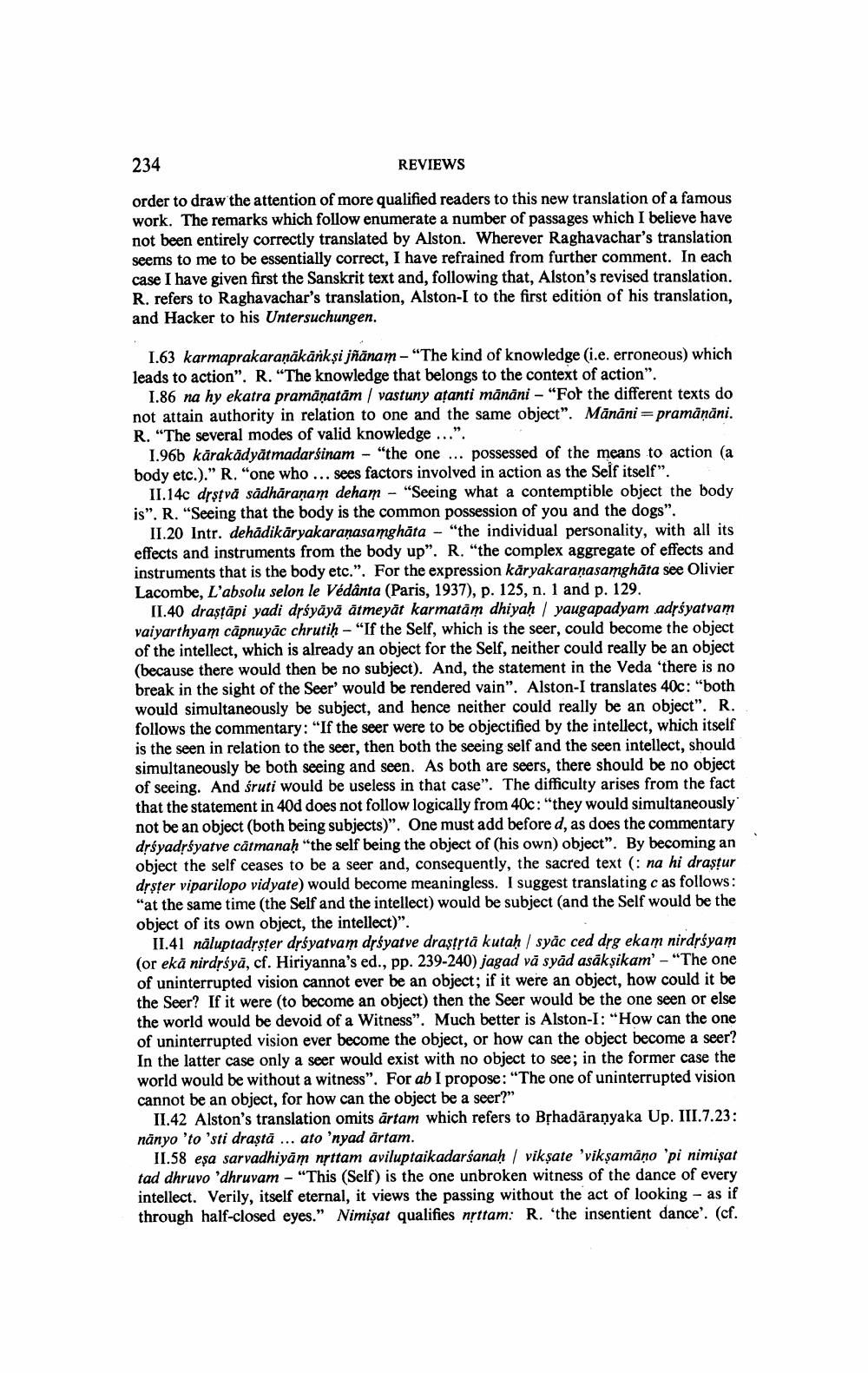________________ 234 REVIEWS order to draw the attention of more qualified readers to this new translation of a famous work. The remarks which follow enumerate a number of passages which I believe have not been entirely correctly translated by Alston. Wherever Raghavachar's translation seems to me to be essentially correct, I have refrained from further comment. In each case I have given first the Sanskrit text and, following that, Alston's revised translation. R. refers to Raghavachar's translation, Alston-I to the first edition of his translation, and Hacker to his Untersuchungen. 1.63 karmaprakaranakanksi jnanam - "The kind of knowledge (i.e. erroneous) which leads to action". R. "The knowledge that belongs to the context of action". 1.86 na hy ekatra pramanatam / vastuny atanti manani - "Fot the different texts do not attain authority in relation to one and the same object". Manani = pramanani. R. "The several modes of valid knowledge ...". 1.96b karakadyatmadarsinam - "the one ... possessed of the means to action (a body etc.)." R. "one who ... sees factors involved in action as the Self itself". II.14c drstva sadharanam deham - "Seeing what a contemptible object the body is". R. "Seeing that the body is the common possession of you and the dogs". II.20 Intr. dehadikaryakaranasamghata - "the individual personality, with all its effects and instruments from the body up". R. "the complex aggregate of effects and instruments that is the body etc.". For the expression karyakaranasamghata see Olivier Lacombe, L'absolu selon le Vedanta (Paris, 1937), p. 125, n. 1 and p. 129. II.40 drastapi yadi drsyaya atmeyat karmatam dhiyah / yaugapadyam adrsyatvam vaiyarthyam capnuyac chrutih - "If the Self, which is the seer, could become the object of the intellect, which is already an object for the Self, neither could really be an object (because there would then be no subject). And, the statement in the Veda 'there is no break in the sight of the Seer would be rendered vain". Alston-I translates 40c: "both would simultaneously be subject, and hence neither could really be an object". R. follows the commentary: "If the seer were to be objectified by the intellect, which itself is the seen in relation to the seer, then both the seeing self and the seen intellect, should simultaneously be both seeing and seen. As both are seers, there should be no object of seeing. And sruti would be useless in that case". The difficulty arises from the fact that the statement in 40d does not follow logically from 40c:"they would simultaneously not be an object (both being subjects)". One must add before d, as does the commentary drsyadrsyatve catmanah "the self being the object of (his own) object". By becoming an object the self ceases to be a seer and, consequently, the sacred text (: na hi drastur drster viparilopo vidyate) would become meaningless. I suggest translating c as follows: "at the same time (the Self and the intellect) would be subject (and the Self would be the object of its own object, the intellect)". II.41 naluptadyster drsyatvam drsyatve drastrta kutah / syac ced drg ekam nirdrsyam (or eka nirdrsya, cf. Hiriyanna's ed., pp. 239-240) jagad va syad asaksikam' - "The one of uninterrupted vision cannot ever be an object; if it were an object, how could it be the Seer? If it were to become an object) then the Seer would be the one seen or else the world would be devoid of a Witness". Much better is Alston-I: "How can the one of uninterrupted vision ever become the object, or how can the object become a seer? In the latter case only a seer would exist with no object to see; in the former case the world would be without a witness". For ab I propose: "The one of uninterrupted vision cannot be an object, for how can the object be a seer?" II.42 Alston's translation omits artam which refers to BIhadaranyaka Up. III.7.23: nanyo 'to 'sti drasta ... ato 'nyad artam. II.58 esa sarvadhiyam nyttam aviluptaikadarsanah / viksate 'viksamano 'pi nimisat tad dhruvo 'dhruvam - "This (Self) is the one unbroken witness of the dance of every intellect. Verily, itself eternal, it views the passing without the act of looking - as if through half-closed eyes." Nimisat qualifies nyttam: R. 'the insentient dance'. (cf.




